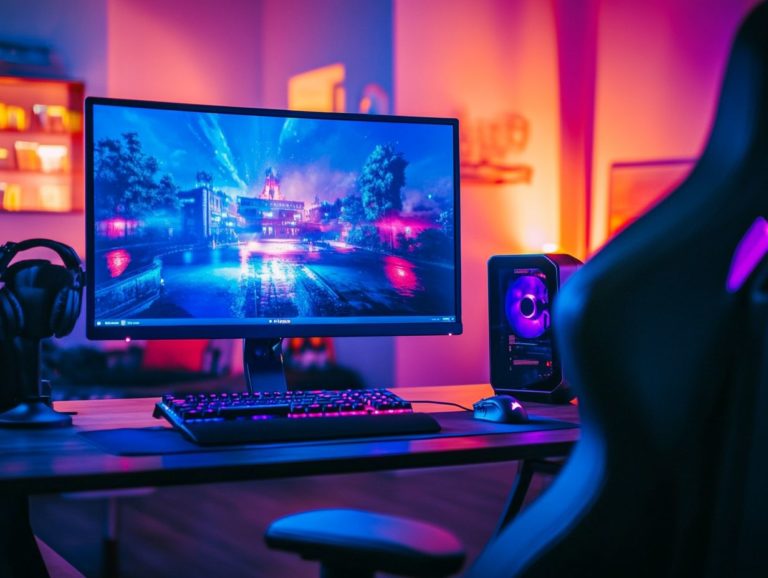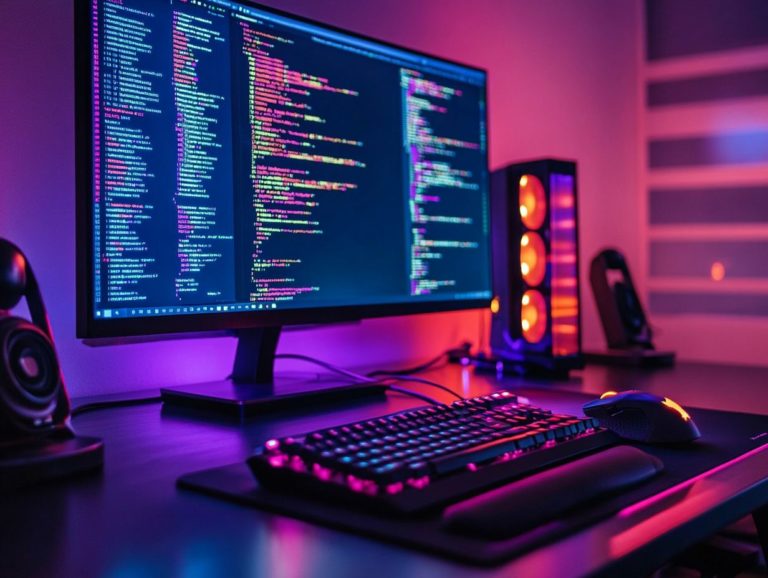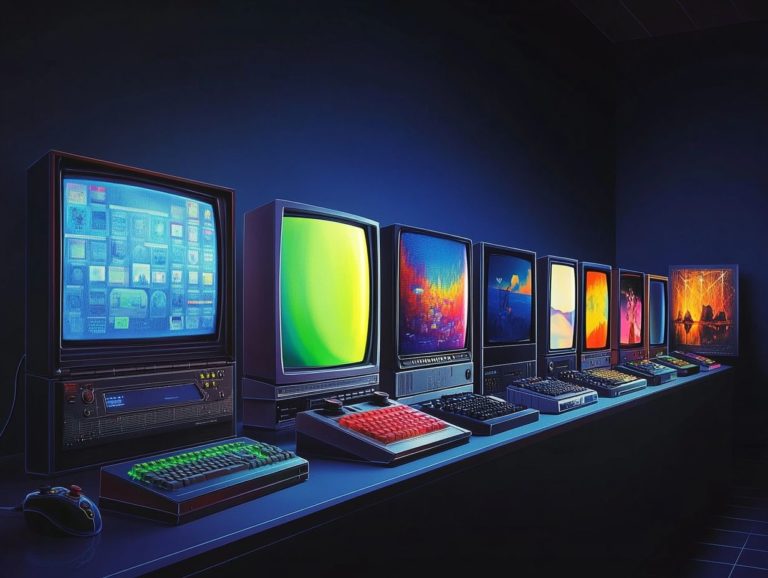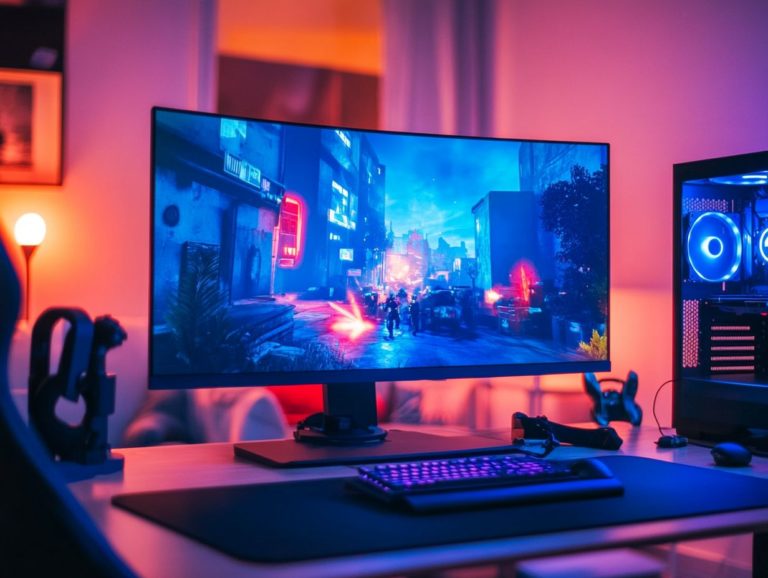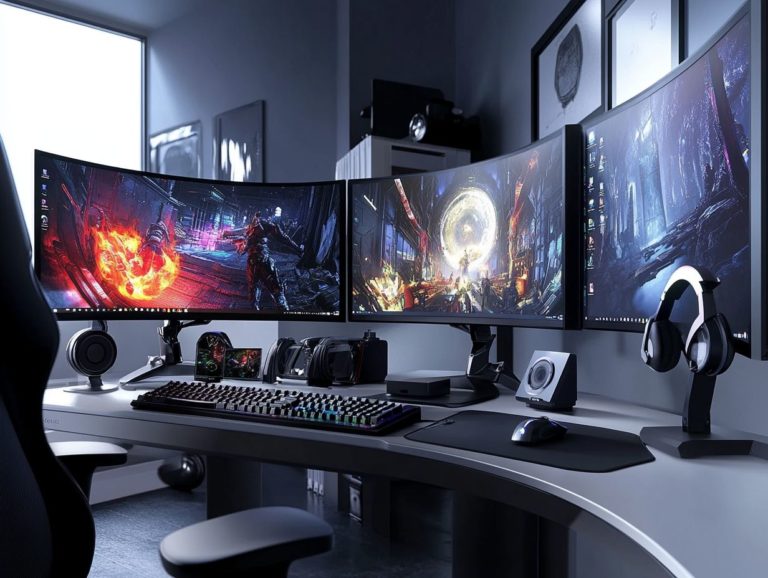refresh rate explained: a gamer’s guide
In the fast-paced realm of gaming, where every millisecond can make a difference, grasping the concept of refresh rate can truly transform your experience.
This guide distills what refresh rate is, why it matters for gamers like you, and how it influences your gameplay and overall performance. It delves into the key factors to consider when choosing the right refresh rate for your setup, provides you with tips to optimize your settings, and clears up common misconceptions that might be swirling around.
Whether you re a seasoned pro or just starting out, this article is designed to help you strike that perfect balance for your gaming adventures.
Contents
- Key Takeaways:
- Understanding Refresh Rate
- Why Refresh Rate Matters for Gamers
- Factors to Consider When Choosing a Refresh Rate
- How to Optimize Refresh Rate for Gaming
- Common Misconceptions About Refresh Rate
- Preguntas Frecuentes
- Qu es la frecuencia de actualizaci n y por qu deber a importarte?
- Cu l es la diferencia entre una frecuencia de actualizaci n de 60Hz y una de 144Hz?
- Todos los juegos se benefician de una alta frecuencia de actualizaci n?
- C mo puedo verificar la frecuencia de actualizaci n de mi monitor?
- Puedo cambiar la frecuencia de actualizaci n de mi monitor?
- Hay un l mite de cu n alta puede ser la frecuencia de actualizaci n de mi monitor?
Key Takeaways:

Higher refresh rates result in smoother and more fluid gameplay, making it crucial for serious gamers.
Consider both hardware requirements and game genre when choosing a refresh rate for an optimal gaming experience.
Adjusting refresh rate settings for different games can greatly improve performance, so don’t be afraid to experiment.
Understanding Refresh Rate
Understanding refresh rate is essential for you as a gamer aiming to elevate your gaming experience. It directly influences the smoothness and responsiveness of your gameplay.
Measured in hertz (Hz), the refresh rate indicates how many times per second your monitor refreshes the image on the screen. This can significantly impact performance across various game genres.
While you might gravitate toward higher refresh rates like 144Hz, 240Hz, or even 360Hz, grasping the nuances of these options gives you the power to select the ideal gaming monitor.
Whether you re considering a budget-friendly choice or investing in a premium monitor equipped with advanced features like G-Sync and FreeSync technologies that reduce screen tearing and provide a smoother gaming experience understanding refresh rates will guide your decision-making process.
What is Refresh Rate?
Refresh rate is the number of times your display refreshes its image each second, measured in hertz (Hz), and it’s a crucial specification for gaming monitors.
A higher refresh rate translates to smoother visuals, significantly enhancing the fluidity of motion in games, making it vital for anyone seeking an immersive gaming experience.
When you compare a monitor operating at 144Hz to a standard 60Hz, the difference in fast-paced action scenes is striking every frame shines with superior clarity and responsiveness.
This feature not only minimizes motion blur but also cuts down on input lag, giving you the power to react more swiftly to on-screen events.
Ultimately, selecting a monitor with an optimal refresh rate can distinguish between victory and defeat, providing you with that coveted competitive edge.
Why Refresh Rate Matters for Gamers
For gamers, refresh rate transcends mere numbers; it can significantly enhance your gameplay experience, especially in fast-paced genres where every millisecond matters.
Embracing a higher refresh rate, like 144Hz or 240Hz, can lead to smoother frame rates, effectively reducing issues such as screen tearing when your monitor shows parts of multiple frames at once, making the image look broken and input lag that can hinder your performance.
Understanding the connection between refresh rate and frame rate is essential for fine-tuning your gaming setup, whether you re engaged in competitive play or enjoying a more casual session.
Impact on Gameplay and Performance
The impact of refresh rate on your gameplay and performance is especially pronounced in competitive gaming scenarios, where low response times and high refresh rates can make all the difference.
In these intense environments, you often rely on split-second reactions to outmaneuver your opponents, making every millisecond count. A higher refresh rate, measured in hertz, ensures that your visuals are smoother, allowing you to track fast-moving objects with greater precision.
This fluidity can be a game-changer during those nail-biting matchups. When combined with low response times, which reduce the lag between your actions and the game s reactions, the overall experience is significantly enhanced.
Competitive gamers discover that upgrading to a monitor with a high refresh rate can truly transform their gaming experience! It sharpens their reflexes and fosters a deeper sense of immersion and control, ultimately leading to superior performance.
Don t wait boost your gaming setup today!
Factors to Consider When Choosing a Refresh Rate
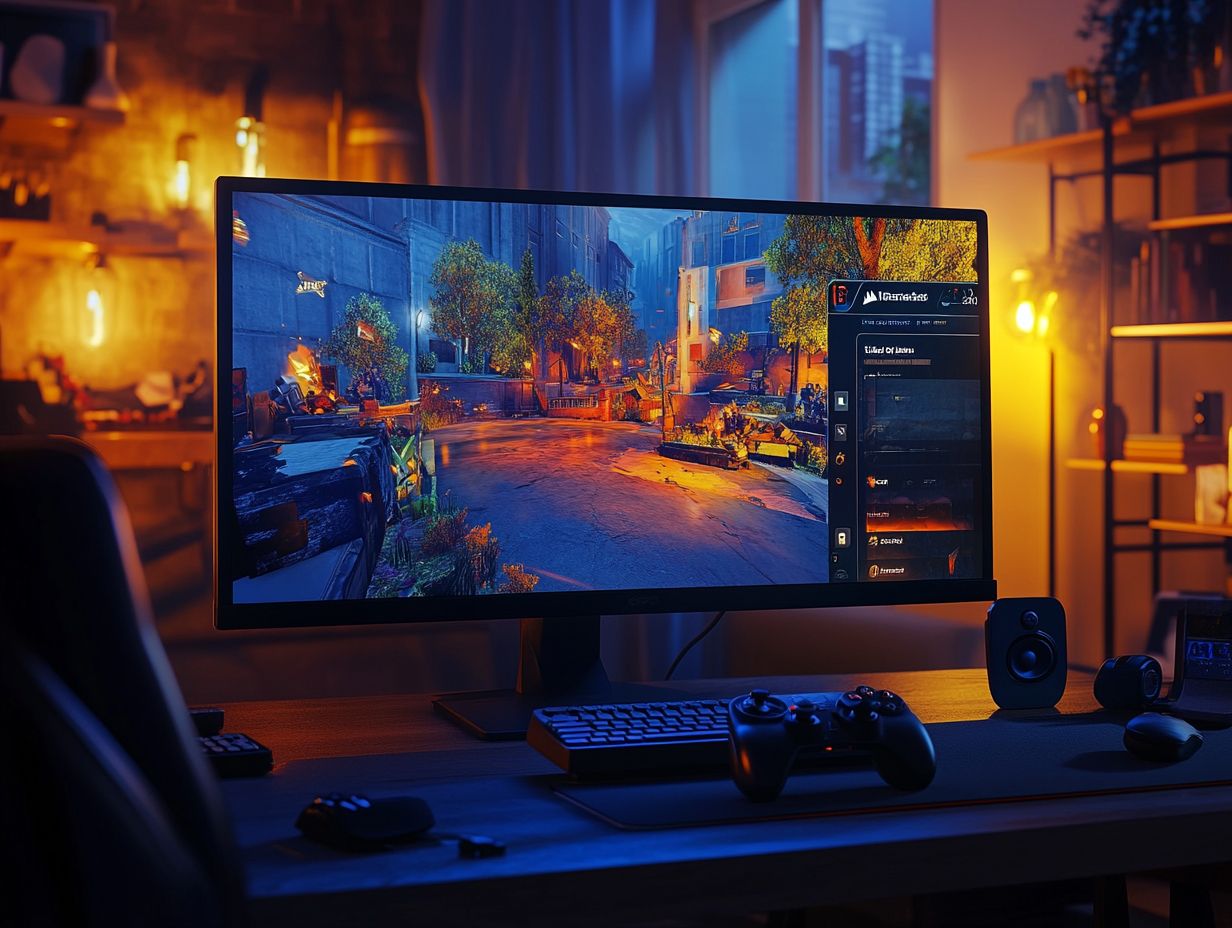
Selecting the perfect refresh rate for your gaming monitor requires careful consideration of several key factors. These include your hardware capabilities, software requirements, budget constraints, and the specific game genres you enjoy.
High refresh rates, like 144Hz and 240Hz, are excellent for fast-paced games. More affordable monitors might feature lower refresh rates that can adequately support less demanding titles.
By assessing your gaming preferences, display size, and resolution, you can make a well-informed decision that enhances your overall gaming experience.
Hardware Requirements
Understanding the hardware requirements is crucial for optimal performance. A powerful graphics card is often necessary to fully support higher refresh rates.
Without the right graphics card, you won t enjoy the full potential of high refresh rates, like 120Hz or even 240Hz.
These capabilities change the game, allowing for smoother gameplay and improved responsiveness essential elements for competitive gaming. Many gamers overlook this vital aspect, focusing only on display specifications.
The synergy between your graphics card and monitor significantly impacts how well games render at impressive speeds. That s why investing in a robust GPU like NVIDIA’s RTX series or AMD’s Radeon RX lineup is essential.
These powerhouses manage frame rates with ease and ensure that visual fidelity remains top-notch, delivering an immersive experience that keeps you engaged and ready to conquer the competition.
Game Genre
Your preferred game genre should play a significant role in determining your refresh rate choice. If you enjoy fast-paced FPS games, a higher refresh rate can dramatically enhance your visuals and gameplay.
Higher refresh rates deliver smoother motion, which is essential for tracking targets and maintaining that all-important competitive edge. Conversely, if RPGs are more your style, you may find that high refresh rates aren t necessary.
RPGs focus on narrative and exploration rather than demanding rapid reflexes. Racing games, however, require quick reactions while thriving on rich graphics and intricate details.
By understanding these distinctions, you can make informed decisions that elevate your overall gaming experience. Choosing the right refresh rate can transform your gaming experience don’t miss out!
How to Optimize Refresh Rate for Gaming
Optimizing the refresh rate for gaming is essential for unlocking the highest level of performance and visual clarity. This involves fine-tuning several settings within your gaming setup.
By enabling technologies such as G-Sync and FreeSync, you can minimize screen tearing and achieve a smoother gameplay experience. These technologies synchronize the refresh rate of your monitor with the frame rate output of your graphics card, ensuring that every moment on-screen is as fluid as possible.
Adjusting Settings for Different Games
Adjusting settings for different games is crucial to maximize your performance and personalize your gaming experience. Each game genre presents unique demands regarding refresh rates and graphic settings.
In first-person shooters, aim for higher frame rates and reduced input lag. This may mean prioritizing lower graphics settings to ensure smooth gameplay.
On the flip side, in role-playing games, you can indulge in richer visuals, cranking up detail levels without sacrificing performance, as these experiences often highlight breathtaking environments.
In racing games, high refresh rates are your best friend for achieving fluid motion, making a noticeable difference in responsiveness.
To craft the ideal setup for each genre, experiment with your system’s capabilities and tweak your preferences accordingly. Find the perfect balance between resolution, texture quality, and shadow settings to reach your optimal play.
Common Misconceptions About Refresh Rate

You might encounter several common misconceptions about refresh rate that could lead you to make uninformed decisions when choosing monitors or configuring your gaming setup.
It s easy to assume that higher refresh rates automatically mean better performance. However, many gamers overlook the significant impact of visual issues like screen tearing, which is a glitch where images don’t line up properly, and motion blur on the overall gaming experience.
Understanding these nuances can dramatically enhance your gaming enjoyment and help you optimize your setup.
Dispelling Myths and Misinformation
Dispelling myths and misinformation about refresh rate is crucial for you as a gamer to make informed decisions regarding your gaming monitors and setups.
Many individuals mistakenly believe that a higher refresh rate guarantees better gaming performance, neglecting other essential factors like response time and the capabilities of your graphics card.
You might think that if your monitor has a refresh rate of 144Hz, you ll always enjoy smoother gameplay. However, that s only true if your system can deliver the necessary frame rates.
Another misconception is that refresh rate doesn t impact casual gaming. In reality, it significantly influences overall visual fluidity and responsiveness.
By understanding these nuances, you can greatly elevate your gaming experience, enabling you to select equipment that genuinely aligns with your needs.
Tips for Finding the Perfect Balance
Finding the perfect balance between refresh rate, performance, and your gaming needs demands a thoughtful approach, considering various factors like your specific gaming setup and monitor capabilities.
Start by outlining your primary gaming genres. Different titles often require unique specifications for optimal performance. For example, if you re diving into competitive first-person shooters, you’ll likely want higher refresh rates and lower response times to gain that edge.
On the other hand, if story-driven RPGs are more your style, a stunning display resolution will help you fully appreciate the rich graphics that make those worlds come alive.
Keeping an eye on your system s specifications is equally crucial. Utilizing tools like GPU-Z or MSI Afterburner can provide valuable insights into your hardware’s performance. Regularly calibrating monitor settings like contrast and brightness will also elevate your gameplay experience, ensuring that each session feels immersive and perfectly tailored to your personal preferences.
Preguntas Frecuentes
En esta secci n, abordamos las preguntas m s comunes sobre la frecuencia de actualizaci n y su impacto en los videojuegos.
Qu es la frecuencia de actualizaci n y por qu deber a importarte?
La frecuencia de actualizaci n es el n mero de veces por segundo que se actualiza la pantalla en tu monitor. Es importante para los videojuegos porque determina cu n suavemente y r pidamente aparece el movimiento en tu pantalla, lo que puede impactar enormemente tu experiencia de juego.
Cu l es la diferencia entre una frecuencia de actualizaci n de 60Hz y una de 144Hz?
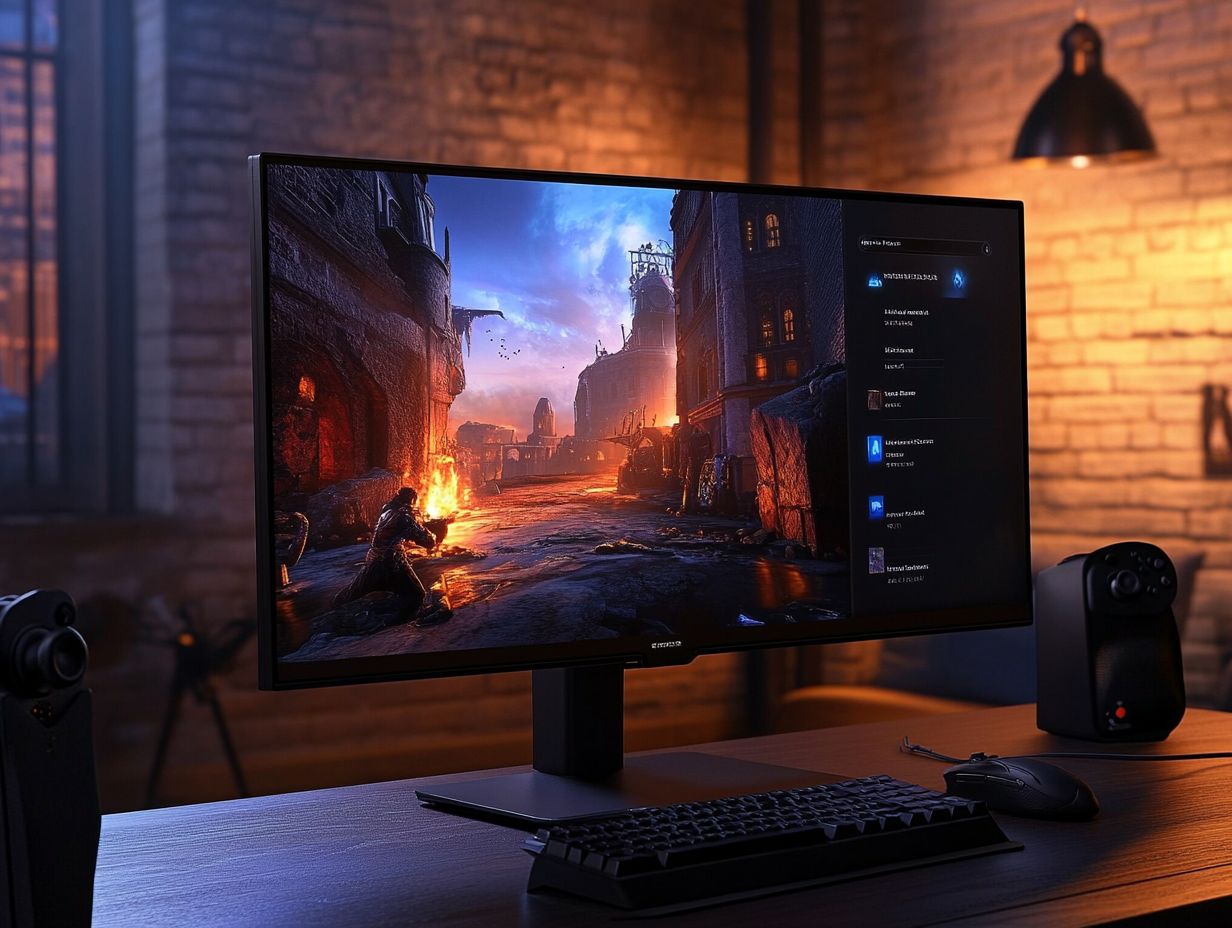
Una frecuencia de actualizaci n de 60Hz significa que la pantalla se actualiza 60 veces por segundo, mientras que una frecuencia de actualizaci n de 144Hz significa que la pantalla se actualiza 144 veces por segundo. Esto significa que una frecuencia de actualizaci n de 144Hz puede mostrar el movimiento de manera m s suave y r pida que una de 60Hz.
Todos los juegos se benefician de una alta frecuencia de actualizaci n?
No, no todos los juegos se beneficiar n de una alta frecuencia de actualizaci n. Algunos juegos, como los de estrategia o rompecabezas, no tienen un movimiento muy r pido y pueden no mostrar una diferencia notable en la jugabilidad con una frecuencia de actualizaci n m s alta. Sin embargo, los juegos de acci n r pida o los disparos en primera persona pueden beneficiarse enormemente de una mayor frecuencia de actualizaci n.
C mo puedo verificar la frecuencia de actualizaci n de mi monitor?
Para verificar la frecuencia de actualizaci n de tu monitor, haz clic derecho en tu escritorio y selecciona “Configuraci n de pantalla”. Luego, haz clic en “Configuraci n de pantalla avanzada” y aparecer una ventana que mostrar la frecuencia de actualizaci n actual de tu monitor.
Puedo cambiar la frecuencia de actualizaci n de mi monitor?
S , puedes cambiar la frecuencia de actualizaci n de tu monitor. Esto es posible si tu tarjeta gr fica y tu monitor lo soportan.
Para hacerlo, ve al panel de control de tu tarjeta gr fica. Tambi n puedes hacer clic derecho en tu escritorio y seleccionar “Configuraci n de pantalla”. Luego, elige “Configuraci n de pantalla avanzada”.
Hay un l mite de cu n alta puede ser la frecuencia de actualizaci n de mi monitor?
S , existe un l mite para la frecuencia de actualizaci n que tu monitor puede tener. Este l mite depende de las capacidades de tu tarjeta gr fica y de tu monitor.
La mayor a de los monitores est ndar tienen una frecuencia m xima de 60Hz. Sin embargo, los monitores dise ados para videojuegos pueden llegar a 240Hz o m s.

